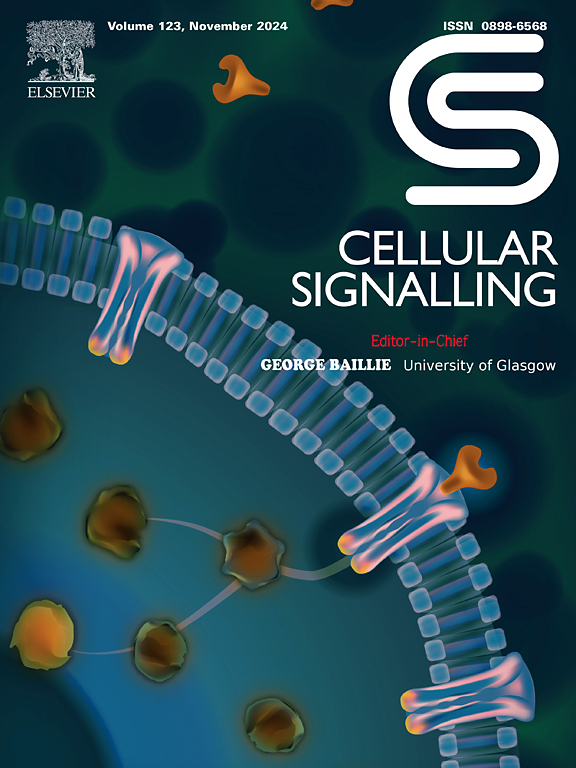IGFBP7: A novel biomarker involved in a positive feedback loop with TGF-β1 in idiopathic pulmonary fibrosis
IF 4.4
2区 生物学
Q2 CELL BIOLOGY
引用次数: 0
Abstract
Idiopathic pulmonary fibrosis (IPF) is a progressive interstitial lung disease characterized by irreversible scarring of the lungs, predominantly affecting older adults. The limited therapeutic options available are largely due to an insufficient understanding of IPF etiology and pathogenesis. This study investigated potential biomarkers to enhance IPF diagnosis and treatment strategies. Through single-cell RNA sequencing (scRNA-seq) and bulk RNA sequencing analyses of public datasets, four hub genes—FTH1, FABP5, DCXR, and IGFBP7—were identified as strongly associated with IPF. Subsequent validation in in vivo and in vitro models confirmed IGFBP7 as a novel biomarker. Double immunofluorescence staining and scRNA-seq analysis revealed that IGFBP7 expression is elevated in IPF epithelial cells. IGFBP7 shows potential for early diagnosis of IPF and can differentiate IPF from other diseases. Gene set enrichment analysis revealed the involvement of IGFBP7 in IPF pathogenesis, particularly through its strong connection to the TGF-β signaling pathway, which drives inflammation and fibrosis. In vitro studies with the TGF-β inhibitor SB431542 showed that inhibition of the TGF-β pathway significantly reduced IGFBP7 expression. Furthermore, IGFBP7 knockdown decreased the expression of markers associated with epithelial-mesenchymal transition and fibrosis while suppressing TGF-β1 expression. These results suggest that IGFBP7 forms a positive feedback loop with TGF-β1. In conclusion, this research identified IGFBP7 as a promising biomarker with significant diagnostic and therapeutic potential for IPF. These insights pave the way for improved diagnostics and the development of targeted antifibrosis therapies, while deepening our understanding of IPF mechanisms.
IGFBP7:一种新的生物标志物,参与特发性肺纤维化与TGF-β1的正反馈回路
特发性肺纤维化(IPF)是一种进行性肺间质性疾病,以不可逆的肺部瘢痕形成为特征,主要影响老年人。有限的治疗选择很大程度上是由于对IPF的病因和发病机制了解不足。本研究探讨了潜在的生物标志物,以提高IPF的诊断和治疗策略。通过单细胞RNA测序(scRNA-seq)和公共数据集的大量RNA测序分析,鉴定出四个中心基因fth1、FABP5、DCXR和igfbp7与IPF密切相关。随后的体内和体外模型验证证实了IGFBP7是一种新的生物标志物。双免疫荧光染色和scRNA-seq分析显示IGFBP7在IPF上皮细胞中表达升高。IGFBP7具有早期诊断IPF的潜力,可以将IPF与其他疾病区分开来。基因集富集分析揭示了IGFBP7参与IPF的发病机制,特别是通过其与TGF-β信号通路的紧密联系,TGF-β信号通路驱动炎症和纤维化。TGF-β抑制剂SB431542的体外研究表明,抑制TGF-β通路可显著降低IGFBP7的表达。此外,IGFBP7敲低降低了与上皮间质转化和纤维化相关的标志物的表达,同时抑制了TGF-β1的表达。这些结果表明IGFBP7与TGF-β1形成正反馈回路。总之,本研究确定IGFBP7是一种有前景的生物标志物,具有重要的IPF诊断和治疗潜力。这些见解为改进诊断和开发靶向抗纤维化疗法铺平了道路,同时加深了我们对IPF机制的理解。
本文章由计算机程序翻译,如有差异,请以英文原文为准。
求助全文
约1分钟内获得全文
求助全文
来源期刊

Cellular signalling
生物-细胞生物学
CiteScore
8.40
自引率
0.00%
发文量
250
审稿时长
27 days
期刊介绍:
Cellular Signalling publishes original research describing fundamental and clinical findings on the mechanisms, actions and structural components of cellular signalling systems in vitro and in vivo.
Cellular Signalling aims at full length research papers defining signalling systems ranging from microorganisms to cells, tissues and higher organisms.
 求助内容:
求助内容: 应助结果提醒方式:
应助结果提醒方式:


